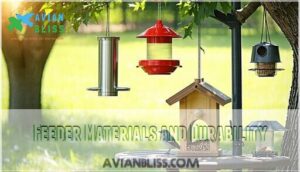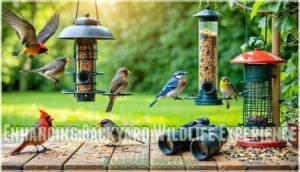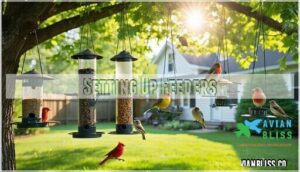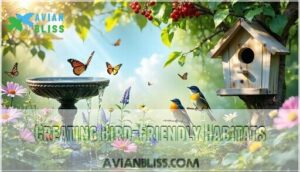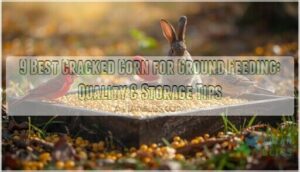This site is supported by our readers. We may earn a commission, at no cost to you, if you purchase through links.

Choose a feeder that suits the birds you want to attract—tube feeders work for small songbirds like finches, while platform feeders welcome larger species, from jays to mourning doves.
Durable materials like metal or UV-resistant plastic last longer, especially against weather or those pesky squirrels.
Cleaning is key—dirty feeders can harm birds, so pick one that’s easy to wash.
Keep feeders filled with fresh seeds like sunflower or millet, and place them where birds feel safe.
Ready to create your own bird haven? There’s more to explore!
Table Of Contents
- Key Takeaways
- Choosing Best Feeders
- Benefits of Wild Feeders
- Top 13 Wild Bird Feeders
- 1. Metal Bird Feeder Tray Platform
- 2. Solar Bird Feeder Lantern Light
- 3. Kaytee Midwest Wild Bird Food 7 Pound
- 4. Squirrel Proof Bird Feeder 4 Ports
- 5. Wagner Cherry Flavor Wild Bird Food
- 6. Wagner Deluxe Wild Bird Food 10lb Bag
- 7. Hanging Bird Feeder Wild Bird Seed
- 8. Hanizi Brown Wild Bird Feeder
- 9. Wagner’s Cherry Flavored Wild Bird Food
- 10. Kingsyard Tube Bird Feeders 2 Pack
- 11. Hanging Wild Bird Seed Feeder
- 12. Kaytee Wild Bird Food Seed Blend
- 13. Clear View Window Bird Feeder
- Setting Up Feeders
- Creating Bird Friendly Habitats
- Frequently Asked Questions (FAQs)
- What is the best feeder for wild birds?
- What is the 5 7 9 rule for bird feeders?
- Can you just throw bird seed on the ground?
- Why put a potato in the bird feeder?
- How do I attract specific bird species?
- What time of year should feeders be used?
- How to prevent bird seed from spoiling?
- Are there feeders suitable for small spaces?
- Which feeder materials are most durable?
- How do I prevent mold in bird feeders?
- Conclusion
Key Takeaways
- Choose a feeder that matches the birds you want to attract and is easy to clean for their health.
- Use durable materials like metal or UV-resistant plastic to withstand weather and deter squirrels.
- Keep feeders filled with fresh seeds like sunflower or millet and place them in safe, visible spots.
- Clean feeders every 2 weeks with soapy water to prevent mold and keep birds healthy.
Choosing Best Feeders
When choosing a bird feeder, you’ll want one that matches the needs of both your backyard birds and your maintenance routine.
Select a bird feeder that meets your feathered friends’ needs while keeping maintenance effortlessly simple for you.
From durable materials to easy-to-clean designs, selecting the right feeder guarantees happier birds and less hassle for you.
Types of Bird Feeders
Bird feeders come in various types, each catering to specific needs.
Hopper feeders boast generous capacity and squirrel resistance, while platform feeders welcome larger birds.
Tube bird feeders attract songbirds, and Nyjer feeders focus on finches.
Suet varieties please woodpeckers, and window feeders offer a cozy view.
Find various models here for attracting different species.
Choose a type that matches your yard’s visitors and feeding goals!
Feeder Materials and Durability
Choosing durable bird feeders starts with the right materials.
Metal strength guarantees longevity, plastic durability keeps upkeep simple, and rust prevention protects against wild weather.
For eco-friendly bird feeding, recycled bird feeders blend sustainability with convenience.
A popular choice involves selecting correct food to attract a variety of birds.
- Stainless steel: Ideal for rust prevention and extended material lifespan.
- Plastic: Lightweight with improved weather resistance.
- Recycled options: Sustainable and durable.
- Metal feeders: Dependable for harsh conditions.
Ease of Cleaning and Maintenance
Keeping your feeder clean keeps your feathered guests healthy.
Opt for feeders that are easy to take apart and scrub. Regular cleaning (every 2 weeks) with brushes and solutions prevents mold and bacteria. Look for designs with drainage holes for drying.
Mold sitting around? That’s no treat! Use this chart to simplify your bird feeder maintenance:
| Task | Tools |
|---|---|
| Cleaning Frequency | Every 2 Weeks |
| Feeder Disassembly | Screwdriver/Hands |
| Material Cleaning | Soapy Water |
| Mold Prevention | Vinegar Solution |
Benefits of Wild Feeders
Wild feeders bring countless benefits to your backyard, from supporting local bird populations to enriching your outdoor space with vibrant wildlife activity.
They also provide a chance to learn about bird behavior while fostering a healthier environment for native species.
Supporting Local Bird Populations
Supporting local bird populations is simpler than you think. Your actions, no matter how small, can make a big impact.
- Use bird feeders with wild bird seed to attract diverse bird species.
- Reduce pesticides to protect their natural food sources.
- Engage in bird conservation through citizen science projects.
- Promote habitat preservation in your community.
- Join community involvement efforts for larger-scale impact.
Consistent observations help with targeted preservation strategies, which is crucial for bird conservation and habitat preservation. This approach allows for targeted preservation and supports local bird populations.
Enhancing Backyard Wildlife Experience
Filling your backyard with bird feeders and wild bird seed turns it into a lively ecosystem.
Attracting wildlife means creating a colorful show of feathered guests.
Use observation techniques to learn their behaviors or try photography tips to capture the moments.
Backyard birdfeeding isn’t just fun, it’s a way to connect with nature and your family alike.
Educational Opportunities for Children
Get kids hooked on birdwatching and exploring nature’s wonders!
Wild bird feeders offer hands-on learning:
- Identify feathered visitors and sharpen birdwatching basics.
- Build bird feeders together—it’s a fun crafting project.
- Discover habitat learning, bird seed types, and conservation awareness.
Feeding birds teaches patience and observation, turning your backyard into an outdoor classroom buzzing with wildlife discoveries.
Top 13 Wild Bird Feeders
Finding the right bird feeder can make a big difference in attracting and supporting your feathered visitors.
Let’s explore 13 exceptional options designed to suit various bird species and backyard setups, ensuring a perfect match for your needs.
1. Metal Bird Feeder Tray Platform
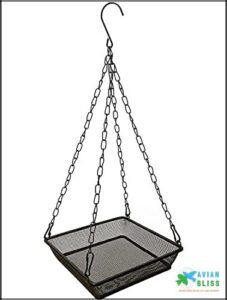
A metal bird feeder tray platform is a simple, durable option for your backyard.
Its rust-free mesh tray drains water, keeping seeds dry and fresh while inviting cardinals, jays, and other feathered friends to snack.
Crafted with lightweight yet sturdy materials, it’s built to handle weather without fuss.
Cleaning’s a breeze—just rinse or wipe it down!
Plus, it adds charm to your garden while offering birds reliable meals.
Consider it a stage for nature’s little performers—you’ll love the show!
Best For: Nature enthusiasts, gardeners, and families who enjoy birdwatching and adding charm to outdoor spaces.
- Susceptible to damage during packaging or shipping.
- Lacks species-specific features for targeted feeding.
- Requires proper placement to attract a variety of birds effectively.
- Durable rust-free mesh design prevents water buildup and keeps seeds dry.
- Easy to clean and maintain with simple rinsing or wiping.
- Sturdy and weather-resistant for long-term outdoor use.
2. Solar Bird Feeder Lantern Light
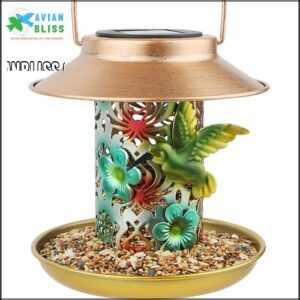
Combining beauty with functionality, this dual-purpose solar bird feeder brings both feathered friends and enchanting nighttime ambiance to your backyard.
The vintage lantern design features three large feeding holes, perfect for attracting cardinals and hummingbirds. Its durable metal construction with anti-rust coating stands up to all weather conditions.
The solar panel charges during daylight hours, automatically illuminating for 8-12 hours at night through its decorative hollow pattern. While not squirrel-proof and requiring careful filling (no more than halfway for maximum light effect), this unique feeder makes an ideal gift for any bird enthusiast.
Best For: Bird lovers who want a decorative feeder that attracts small birds and adds ambiance to their backyard with solar-powered lighting.
- Not squirrel-proof, which can lead to seed theft.
- Small opening makes filling seeds a bit tricky.
- Solar light performance may be affected by surrounding bright lights.
- Dual-purpose design as both a bird feeder and solar garden lantern.
- Durable metal construction with anti-rust and waterproof features for all-weather use.
- Beautiful hollow pattern design creates charming nighttime light projections.
3. Kaytee Midwest Wild Bird Food 7 Pound
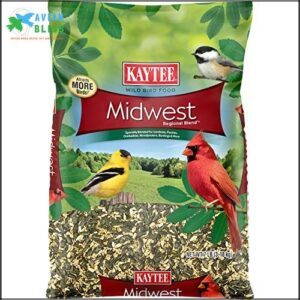
You’ll be amazed at how Kaytee Midwest Wild Bird Food stands out from the crowd.
Preferred 3-to-1 over black oil sunflower by songbirds nationwide, this 7-pound blend is scientifically formulated to attract regional birds.
The mix contains sunflower hearts, niger seed, safflower, and both red and white millet—perfect for cardinals, finches, chickadees, and woodpeckers.
Independent university research confirms it attracts more birds than standard seeds or non-regional blends, and birds consume it without waste, reducing ground mess.
If you’re not satisfied, Kaytee offers a money-back guarantee with your invoice, which is a significant advantage, making it a reliable choice with regional birds.
Best For: Bird enthusiasts in the Midwest looking to attract a variety of regional species like cardinals, finches, and woodpeckers with a proven, mess-reducing seed blend.
- Can create messiness under feeders despite reduced waste.
- Popular with squirrels and other wildlife, which may deter birds.
- Requires regular restocking due to quick consumption by birds.
- Attracts a wide range of birds, including colorful species like cardinals and goldfinches.
- Reduces ground mess as birds consume the blend efficiently.
- Money-back guarantee ensures customer satisfaction.
4. Squirrel Proof Bird Feeder 4 Ports
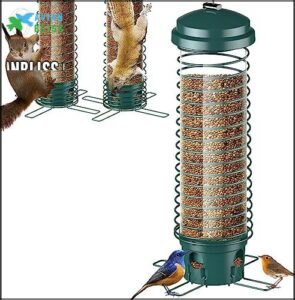
The Squirrel Proof Bird Feeder with 4 ports offers a clever solution to the age-old battle between birds and squirrels.
Its metal spring mechanism automatically blocks feeding ports when squirrels climb on, working effectively about 80% of the time.
You’ll appreciate the durable construction with a secure metal top clip and rust-proof coating that stands up to various weather conditions.
It’s compatible with multiple seed types including millet, sunflower, safflower, and peanuts.
The clear plastic tube lets you easily monitor seed levels while extended perches provide comfortable access for your feathered visitors, making it a great option for those who want to attract birds with multiple seed types.
Best For: Bird enthusiasts seeking a durable and weather-resistant feeder that accommodates multiple seed types while minimizing squirrel interference.
- Squirrel-proofing is only effective about 80% of the time.
- Squirrels may still access seeds using perches or by dislodging the lid.
- Requires regular cleaning to maintain hygiene.
- Durable, rust-proof design with a secure metal top clip.
- Compatible with various seed types for attracting different birds.
- Clear plastic tube for easy seed level monitoring.
5. Wagner Cherry Flavor Wild Bird Food

When you’re looking to attract a variety of backyard birds without breaking the bank, Wagner Cherry Flavor Wild Bird Food offers an economical solution.
This value-priced mix contains general-purpose seeds including millet, milo, cracked corn, and sunflower—perfect for ground feeders and many common species.
You’ll appreciate that it’s made in the USA with high-quality grains and comes in convenient 20-pound bags.
The cherry flavoring is a unique addition that helps attract different birds to your yard, and simply using it in your hopper or tube feeders will bring a steady stream of feathered visitors.
Best For: Bird enthusiasts looking for an affordable, convenient mix to attract a wide variety of backyard and ground-feeding birds.
- Value-priced mix with general-purpose seeds attracting diverse bird species.
- Made in the USA with high-quality grains and no artificial additives.
- Cherry flavoring designed to attract more birds.
- Some birds may not show interest, leading to seed wastage.
- Aggressive birds like grackles may dominate feeders.
- May require mixing with other seeds to better manage bird variety.
6. Wagner Deluxe Wild Bird Food 10lb Bag
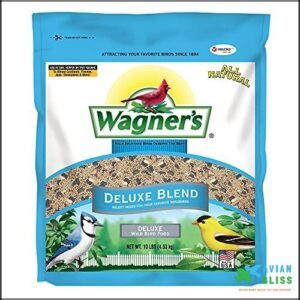
You’ll transform your backyard into a lively bird sanctuary with Wagner Deluxe Wild Bird Food.
This 10lb bag contains 20% sunflower seeds mixed with millet, milo, and cracked corn—attracting both perching and ground birds.
Cardinals, chickadees, finches, and blue jays will flock to your feeders when filled with this nutritious blend.
Made in the USA with high-quality grains, this moderately priced mix offers excellent value with minimal waste.
The resealable packaging keeps seeds fresh longer.
While some birds might toss less desirable seeds, the overall attraction power makes this a practical choice for backyard bird enthusiasts.
Best For: Backyard bird enthusiasts who want an economical, high-quality seed blend to attract a variety of bird species.
- Attracts a wide range of birds, including cardinals and chickadees.
- High-quality grains with resealable packaging for freshness.
- Moderately priced for great value.
- Contains milo and cracked corn, which some birds may toss out.
- Not completely filler-free compared to premium blends.
- Larger bag sizes are only available from alternative brands.
7. Hanging Bird Feeder Wild Bird Seed
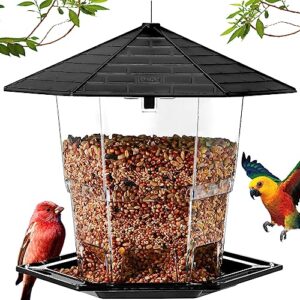
When you’re looking to attract diverse bird species to your yard, this expandable hanging feeder offers an impressive 2.2-pound seed capacity that reduces your refill frequency.
Its clever hexagonal roof design prevents seed clogging while protecting birds from rain during feeding sessions.
You’ll appreciate the user-friendly latch mechanism that makes opening, filling, and cleaning a breeze.
The durable plastic construction withstands outdoor conditions year-round, and the included wire cable means you’re ready to hang it immediately.
While some users report mixed seed compatibility issues, this affordable feeder still delivers excellent value for backyard bird enthusiasts.
Best For: Homeowners and bird enthusiasts looking for an affordable, easy-to-use feeder to attract small to medium-sized bird species.
- Not ideal for larger birds or mixed seed types.
- Some users report seed flow issues with certain seeds.
- Plastic material may not meet all durability expectations.
- Expandable 2.2-pound seed capacity reduces refills.
- Durable, weather-resistant plastic for year-round use.
- Easy-to-use latch mechanism for quick filling and cleaning.
8. Hanizi Brown Wild Bird Feeder
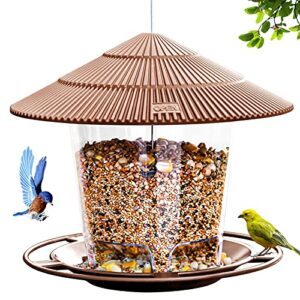
While many bird feeders claim to be squirrel-proof, the Hanizi Brown Wild Bird Feeder actually delivers with its clever twist lock design.
This lightweight yet durable plastic feeder holds up to 47 ounces of seed, meaning you’ll spend less time refilling and more time bird-watching.
Its clear body lets you easily monitor seed levels, while the inclined roof keeps seeds dry during rainy weather.
Though smaller birds like finches and chickadees will love it, larger birds might find the perching area too restrictive.
Regular cleaning with mild soap and water keeps it in top condition and ensures the feeder remains functional with its clever twist lock design.
Best For: Bird enthusiasts looking for a lightweight, squirrel-resistant feeder suited for small to medium-sized birds.
- Lightweight and holds up to 47 oz of seed for less frequent refills.
- Squirrel-resistant twist lock design protects seeds.
- Clear plastic body allows easy monitoring of seed levels.
- Small perching area unsuitable for larger birds.
- Central hanging cable can allow water into the seed chamber.
- Plastic construction may feel cheap to some users.
9. Wagner’s Cherry Flavored Wild Bird Food
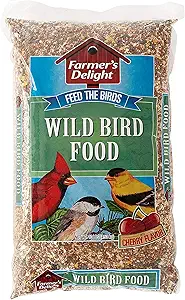
The Wagner’s Cherry Flavored Wild Bird Food offers an economical option for attracting diverse backyard visitors.
This 10-pound bag contains a blend of sunflower, millet, milo, and cracked corn—all made in the USA with high-quality grains.
You’ll find it works well in hopper or tube feeders, drawing finches, wrens, and sparrows to your yard.
While some birds may avoid the milo seeds, many customers appreciate its affordability and cherry scent.
For best results, place your feeder over grass to minimize cleanup issues from visiting pigeons that particularly enjoy this blend.
Best For: Bird enthusiasts seeking an affordable and versatile bird food option that attracts a variety of backyard birds, especially for use in hopper or tube feeders.
- Economical option with high-quality ingredients.
- Cherry flavor attracts a variety of bird species.
- Compatible with multiple feeder types for convenience.
- Milo seeds may be avoided by certain bird species, leading to waste.
- Pigeons are highly attracted to the mix, increasing mess and cleanup.
- Some customers report birds wasting filler seeds while feeding.
10. Kingsyard Tube Bird Feeders 2 Pack
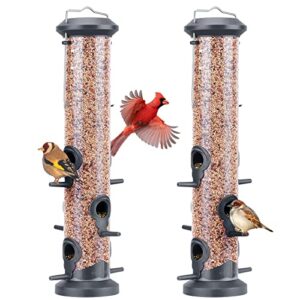
Why settle for one bird feeder when you can attract twice the feathered visitors?
The Kingsyard Tube Bird Feeders 2 Pack offers durable plastic construction with six feeding ports on each feeder, inviting multiple birds to dine simultaneously.
Each feeder holds 2 lbs of seed and features built-in drainage holes to prevent mold, while the transparent compartment lets you monitor seed levels easily.
They’ve withstood 70 mph winds in users’ yards, though their lightweight design means you might want to bring them in during storms.
Perfect for budget-conscious bird enthusiasts seeking reliable performance.
Best For: Budget-conscious bird enthusiasts looking to attract multiple birds with durable and functional feeders.
- Lightweight design may require removal during storms.
- Small top opening can make refilling challenging.
- Some users report flimsy construction despite overall durability.
- Six feeding ports on each feeder for multiple birds.
- Built-in drainage holes prevent mold buildup.
- Transparent compartment for easy seed level monitoring.
11. Hanging Wild Bird Seed Feeder

This hanging wild bird seed feeder holds an impressive 2.2 lbs of seed with six feeding ports, making it a popular gathering spot for neighborhood birds.
You’ll appreciate its waterproof roof and bottom tray that keep seeds dry through rainy days.
The durable plastic construction guarantees longevity, while the twist-open top makes refilling and cleaning a breeze.
Many bird enthusiasts report regular visits from chickadees and cardinals, noting how effectively it deters pesky insects like bees and wasps.
At 7.5"L x 7.5"W x 8.7"H, it’s the perfect size for most garden spaces, and the included lanyard makes hanging simple.
Best For: Bird enthusiasts, gardeners, and nature lovers who want an easy-to-maintain feeder that attracts birds while deterring insects.
- Plastic material may not appeal to those seeking a more natural aesthetic.
- Crevices can be tricky to clean thoroughly.
- May require relocation or additional measures to deter squirrels.
- Holds up to 2.2 lbs of seed with six feeding ports for multiple birds.
- Waterproof design keeps seeds dry in various weather conditions.
- Twist-open top allows for quick refilling and cleaning.
12. Kaytee Wild Bird Food Seed Blend
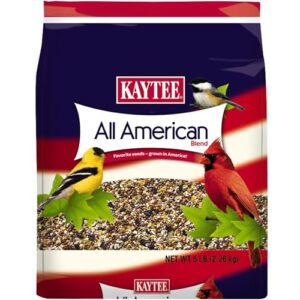
Everyone deserves a premium seed blend that attracts a variety of colorful visitors to their yard.
Kaytee’s 5-pound Wild Bird Food Seed Blend delivers exactly that, packed with black oil sunflower seeds—a favorite among wild birds.
This USA-grown mixture includes carefully selected seeds and grains, all housed in a convenient resealable bag that maintains freshness.
You’ll soon notice up to 16 different species flocking to your feeders, though be prepared for frequent refills as birds consume this popular blend quickly.
For best results, store in a cool, dry place and clean feeders regularly to ensure the freshness of the seed blend and the health of the birds, which will be enjoying their new favorite food.
Best For: Homeowners and bird enthusiasts looking to attract a variety of colorful wild birds to their yard.
- Requires frequent refills as birds consume the blend quickly.
- May attract squirrels, needing added deterrents.
- Birds may prefer specific seeds, like sunflower seeds, over others in the mix.
- Attracts up to 16 different bird species with a high-energy seed blend.
- Convenient resealable bag keeps feed fresh and easy to store.
- Good value for price with quality ingredients grown in the USA.
13. Clear View Window Bird Feeder

Bring nature directly to your window with the Clear View Window Bird Feeder. This innovative design features four strong suction cups that securely attach to any window, offering an unobstructed view of your feathered visitors.
The 2-cup seed capacity with rounded perch keeps birds comfortable while feeding, and the UV-stabilized plastic guarantees lasting durability through all seasons.
You’ll appreciate the removable seed tray that makes refilling and cleaning a breeze. The channeled, perforated base promotes proper drainage to keep seeds fresh.
Perfect for introducing children to birdwatching or bringing joy to anyone who loves nature, with the added benefit of a removable seed tray.
Best For: Bird lovers, nature enthusiasts, and families seeking an easy-to-use feeder for close-up birdwatching experiences.
- Secure window mounting with sturdy suction cups for unobstructed views.
- Removable seed tray for easy refilling and cleaning.
- Durable UV-stabilized plastic ensures long-term use in all seasons.
- Seed leakage may occur due to the low barrier design.
- Suction cups may detach if not properly maintained or repositioned.
- Compact size limits the amount of seed it can hold.
Setting Up Feeders
You’ll transform your backyard into a bustling avian hotspot by strategically positioning your feeders in locations that balance visibility with protection from predators.
Proper setup, including stable mounting and regular maintenance, guarantees your feathered visitors will return again and again for their nutritious meals, and this will make your backyard a bustling place.
Optimal Feeder Placement
Location wisdom guides successful bird feeding.
Place your feeders 10-12 feet from shrubs for predator avoidance while allowing birds quick cover access.
Different bird feeder types need specific positioning – hang tube feeders higher for small songbirds, while platform feeders work better at lower heights.
Consider weather protection, ensuring feeders stay dry and visible.
Year-round accessibility needs change with seasons, so adjust placement accordingly for species specificity.
Seed Selection and Storage
Now that you’ve positioned your feeders strategically, let’s talk about keeping your bird seed fresh.
Proper storage of wild bird food guarantees you’re attracting birds with quality offerings. Store seeds in airtight containers in a cool, dry place below 40°F with humidity under 40%.
Consider seed container options for ideal preservation.
Label containers with seed types and purchase dates. This organization prevents spoilage and helps you track which seeds are squirrel favorites versus bird preferences.
Regular Cleaning and Refilling
Now that you’ve selected the right seeds, let’s talk about keeping those feeders pristine. Your bird feeder cleaning routine is just as important as what you put in it.
Clean feeders every two weeks with mild soap and water to prevent disease transmission among your feathered visitors. Regular cleaning prevents potential mold growth which can be harmful to birds.
Don’t wait until seed spoilage occurs—empty, scrub, and thoroughly dry feeders before refilling. Your birds will thank you with continued visits, ensuring a healthy and pristine environment for them to enjoy, with regular cleaning being key to their well-being.
Creating Bird Friendly Habitats
You’ll create more than just a feeding station when you transform your yard into a complete bird sanctuary with native plants and water features.
Your feathered visitors will reward your efforts with increased activity and diversity, turning your backyard into a thriving ecosystem that supports local wildlife populations.
Planting Native Vegetation
Now that your feeders are set up, let’s enhance your bird-friendly environment with native vegetation.
Plant local species like Eastern Wild-rye and Speckled Alder to provide natural cover from predators and harsh weather.
Native plants offer additional food sources through seeds, fruits, and by attracting insects that birds love.
For ideal growth, space potted plants 18 inches apart and include evergreen shrubs for year-round habitat support and bird conservation.
Providing a Source of Water
Everyone knows a good bird feeder setup isn’t complete without a reliable water source. Birds need water not just for drinking but for bathing and preening too.
Adding a water feature dramatically increases your backyard’s bird-friendly appeal. A great option for attracting birds is a classic backyard feature.
- Choose from shallow bird bath types (pedestal, hanging, or ground models)
- Position your water source within 10-15 feet of protective cover
- Clean water features weekly to prevent algae and disease
- Use bird bath heaters in winter for preventing freezing
- Create gentle water movement to increase attracting birds
Creating a Bird-Friendly Habitat
Native plants, water sources, and shelter options can transform your yard into a bird-friendly environment.
Add nesting sites and use bird feeders with diverse bird food to attract species year-round. Predator control helps birds feel safe, while bird seed storage guarantees a lasting supply.
A balance of food, water, and shelter turns your space into paradise for feathered friends.
Consider growing native plants to provide essential food and shelter.
Frequently Asked Questions (FAQs)
What is the best feeder for wild birds?
The best feeder for wild birds depends on your goals.
Tube feeders attract songbirds, suet feeders draw woodpeckers, and platform feeders welcome all types.
Choose squirrel-proof designs if theft’s a problem—wild birds will thank you!
What is the 5 7 9 rule for bird feeders?
The "5-7-9 rule" helps with bird feeder heights: place feeders 5 feet to block predators, 7 feet from jumping squirrels, and 9 feet from branches or walls for safety and better viewing.
Can you just throw bird seed on the ground?
Sure, you can toss bird seed on the ground, but expect a mixed crowd—songbirds, ground-feeders, and maybe squirrels.
It’s like hosting a backyard buffet, but keep it clean to avoid pests and disease.
Why put a potato in the bird feeder?
Ever wonder why you’d stick a potato in a bird feeder?
It’s a clever way to block holes temporarily during cleaning or repairs—simple, effective, and oddly satisfying, like using duct tape for unexpected fixes!
How do I attract specific bird species?
To attract specific bird species, offer their favorite food, like Nyjer seeds for finches or suet for woodpeckers.
Use the right feeder type, place it safely, and keep it clean to encourage visitors.
What time of year should feeders be used?
Picture your yard alive with fluttering feathers—feeders are handy year-round!
Winter offers food scarcity, spring supports nesting birds, and summer caters to fledglings.
Just clean regularly to keep those feathered guests healthy and happy!
How to prevent bird seed from spoiling?
Keep seeds fresh by using airtight feeders, cleaning them regularly, and only filling enough for a few days.
Place feeders in shaded spots, and store extra seed in cool, dry, pest-proof containers.
Are there feeders suitable for small spaces?
Good things come in small packages," they say, and compact feeders like window-mounted or tube feeders fit the bill.
These maximize vertical space, attract varied birds, and provide close-up birdwatching, even in cozy spaces.
Which feeder materials are most durable?
Metal and stainless steel feeders are your go-to for durability.
These materials withstand weather, resist rust, and deter chewing animals like squirrels.
Plus, they’re easy to clean, keeping your feathered friends healthier and happier.
How do I prevent mold in bird feeders?
Clean your feeder regularly, at least once a week.
Provide proper drainage, use seed trays to avoid excess moisture, and store feed in a dry place.
Damp seeds invite mold faster than you’d think!
Conclusion
Surprisingly, setting up a wild bird food feeder helps your feathered friends and also transforms your backyard into a lively, natural retreat.
With the right feeder, durable materials, and proper cleaning, you’ll guarantee a safe, inviting spot for local birds.
Add fresh seeds, place feeders strategically, and even plant native greenery to enhance the habitat.
A little effort goes a long way—soon, your yard will buzz with delightful birdsong and vibrant wildlife activity!
- https://order.wbu.com
- https://wordpress.org/plugins/gdpr-cookie-compliance/
- https://www.homedepot.com/p/Wagner-s-10-lb-Finches-Deluxe-Wild-Bird-Food-62071/202260359
- https://www.sears.com/wagner-s-wagner-s-13008-deluxe-wild-bird-food-10/p-SPM8847086023?sid=ISxMP3xSOxGGxDTxSURF
- https://www.chewy.com/wagners-deluxe-blend-wild-bird-food/dp/124506


